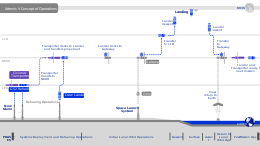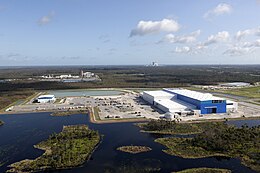 Artemis V concept of operations with Blue Moon | |
| Manufacturer | Blue Origin |
|---|---|
| Country of origin | United States |
| Operator | NASA, Blue Origin |
| Applications | Crewed and robotic reusable lunar landing |
| Specifications | |
| Spacecraft type | Lunar lander |
| Launch mass | >45,000 kg (99,000 lb)[1] |
| Dry mass | 16,000 kg (35,000 lb)[1] |
| Payload capacity | 20,000 kg (44,000 lb) (cargo variant, reusable) 30,000 kg (66,000 lb) (cargo variant, one-way)[2] |
| Crew capacity | 4 |
| Regime | |
| Design life | 30 days |
| Dimensions | |
| Height | 16 m (52 ft)[1] |
| Production | |
| Status | In development |
| Manufacturer | Blue Origin |
|---|---|
| Country of origin | United States |
| Operator | Blue Origin |
| Applications | Robotic lunar landing |
| Specifications | |
| Spacecraft type | Lunar lander |
| Launch mass | 21,350 kg (47,070 lb) |
| Payload capacity | 3,000 kg (6,600 lb) |
| Dimensions | |
| Height | 8.05 m (26.4 ft) |
| Diameter | 3.08 m (10.1 ft)[3] |
| Production | |
| Status | In development |

Blue Moon is a family of lunar landers and their associated infrastructure, intended to carry humans and cargo to the Moon, under development by a consortium led by Blue Origin and including Lockheed Martin, Draper, Boeing, Astrobotic, and Honeybee Robotics. Two versions of Blue Moon are under development: a robotic lander planned to land on the Moon in 2024,[4][5] and a larger human lander planned to land a crew of four astronauts on the lunar surface for the NASA Artemis V mission in 2029.[6]
Development of the smaller, uncrewed lander began in 2016 and was publicly revealed in 2017. It is planned to be capable of delivering up to 3.0 tonnes (3.3 short tons) of payload to the surface of the Moon.[7] Originally envisioned as a way to gain experience with lunar landings and to support technology development, MK 1 is also marketed independently of MK2. The lander has been proposed for a number of projected roles; an initial goal was a lunar south pole landing, where it was proposed that a series of landings could be used to deliver the infrastructure for a Moon base.[4][5][8] Blue Moon formed the basis of part of the Integrated Lander Vehicle, a proposal for a human lander bid, but was not chosen for the Artemis HLS program.[9]
The human lander, referred to as MK2,[2] was chosen by NASA as the winner of the Sustaining Lunar Development Human Landing System contract in May 2023. It is the second human lunar lander under contract by NASA for the Artemis HLS program, alongside Starship HLS.[10] It is intended to carry up to 4 astronauts to the lunar surface for up to 30 days in a fully reusable configuration, with a cargo variant also planned.[2] The lander is designed to be paired with a space tug called the Cislunar Transporter, to be built by Lockheed Martin.[1] The Cislunar Transporter is launched in two parts, a tug and a tanker, to low Earth orbit before refueling Blue Moon in a lunar near-rectilinear halo orbit.[11] Both MK2 and the Cislunar Transporter are to be powered by three BE-7 engines burning liquid hydrogen fuel and liquid oxygen oxidizer.[7] They are intended to make use of new cryogenic fluid management technologies under development, including those to enable long-term on-orbit storage of their cryogenic propellants.[12]
- ^ a b c d Foust, Jeff (2023-05-19). "NASA selects Blue Origin to develop second Artemis lunar lander". SpaceNews. Retrieved 2023-05-19.
- ^ a b c "Once again, NASA leans into the future by picking an innovative lunar lander – Ars Technica". 2023-05-19. Retrieved 2023-05-19.
- ^ Foust, Jeff (2024-08-12). "NASA payload to fly on first Blue Origin lunar lander mission". SpaceNews. Retrieved 2024-08-13.
- ^ a b Cite error: The named reference
inverse-2017-04-07was invoked but never defined (see the help page). - ^ a b Davenport, Christian (2 March 2017). "An exclusive look at Jeff Bezos's plan to set up Amazon-like delivery for 'future human settlement' of the moon". The Washington Post.
- ^ Chang, Kenneth (2023-05-19). "NASA Picks Blue Origin's Blue Moon Lander for Artemis V Mission". The New York Times. ISSN 0362-4331. Retrieved 2023-05-19.
- ^ a b Klotz, Irene (2023-07-17). "Doing Business on the Moon". Aviation Week and Space Technology. pp. 32–35.
- ^ Boyle, Alan (20 May 2017). "Jeff Bezos lays out his vision for city on the Moon, complete with robots". GeekWire.
- ^ Betz, Eric (2021-04-05). "Blue moon: Will Jeff Bezos' lunar lander return astronauts to the Moon?". Astronomy Magazine. Retrieved 2023-07-18.
- ^ O’Shea, Claire (2023-05-19). "NASA Selects Blue Origin as Second Artemis Lunar Lander Provider". NASA. Retrieved 2023-05-19.
- ^ "Space Business: Cold Storage". Quartz. 2023-06-08. Retrieved 2023-06-09.
- ^ Davenport, Christian (2023-05-19). "Bezos's Blue Origin wins NASA contract to land astronauts on the moon". The Washington Post. Retrieved 2023-05-19.